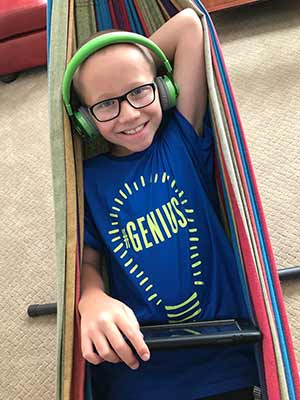Is your child struggling to read?
Reading is the key to learning success, but many children struggle to learn how to read during their younger years. Printed text can create obstacles for children with learning differences, like dyslexia, who find it challenging to learn how to decode words and comprehend meaning. This leads to falling behind in class, and a cycle of academic failure at a very young age.
Today 30 million students struggle to read, and one in five students has a learning disability. These children are often persistently slow in their rate of response to instruction, and struggle to read independently. In the fourth grade students are no longer learning to read, but are expected to have mastered the skill of reading. If reading deficits go unnoticed by fourth grade, over 65% of children will read below proficiency, unable to absorb complex texts.

What the science says about how the brain learns to read
A growing body of evidence suggests that developmental dyslexia might arise from impaired information processing, which is based on disruptive neural responses. Psychologist and Cognitive Neuroscientist, Stanislas Dehaene, PhD, is the Chair of Experimental Cognitive Psychology at the Collége de France in Paris, and directs the NeuroSpin center foremost in advanced brain imaging. Dehaene’s research investigates the neural bases of human cognitive functions such as reading, and language, with particular interest on the impact brain-based learning has in education.
Learning to read consists of recognizing letters and how they combine into written words, and then connecting them to the brain systems for coding of speech sounds and for meaning. According to Dr. Dehaene, reading starts in our brains like any other visual stimulation in the general visual areas of the brain, but quickly moves into an area of the brain that concerns the recognition of the written word. He calls this area the brain’s “letter box” because it stores our knowledge of letters. From there, an explosion of activity happens in at least two important brain networks; one that concerns the meaning of words, and one that concerns the pronunciation and articulation of words. Dr. Dehaene says, “The beginning reader’s brain acts as a “super-computer” that needs to be fed with structured inputs, a well-designed curriculum, and explicit teaching of phonics and spelling.”
Breaking down barriers to reading
Learning Ally’s human-read audiobook solution is proven to double the rate of reading growth in just 50 days. It is a supplemental reading tool that empowers children and adolescents to become confident readers, effective communicators, and empathetic individuals. Access to books in digital format can reduce the stress and anxiety many struggling readers endure, especially those with dyslexia. Learning Ally has a dyslexia screening tool that will aid you in determining if your child has early reading difficulties. Your child may already qualify for Learning Ally if they have an Individual Education Plan.
The organization’s digital audiobook library is filled with K-12 textbooks and culturally rich, age-appropriate, stories to assist children in reading about, and identifying with, their heritage, unique interests, and personal aspirations. Instead of frustration and angst for your child, this audiobook solution can pique their curiosity, imagination, and enthusiasm for a new world of learning, driven by their innate desire for knowledge, exploration, and self-awareness. As children enjoy best-sellers and receive the textbooks they need for school, they can improve their academic potential and social connections with classmates, teachers, and family. They feel part of their school community of good readers and participate in class.

Benefits of human-read audiobooks in support of struggling readers
Research tells us that children who listen to audiobooks can recall information more readily. Listening to audiobooks improves speaking accuracy and fluency, and access to anytime and anywhere reading independently.
Using the Learning Ally app, students have access to interactive learning tools geared to help them succeed in school, including:
- highlighted text synced with audio narration
- speed control
- in-app dictionary
- bookmarking, highlighting, and annotating features.
As children simultaneously see the words and hear text spoken with human-narration, their brains can better connect words to vocabulary, speech, and context. With human narration, a child can notice correct pronunciation, recognize and learn new words, get a flow of reading rate, pauses, stresses, and intonations – all skills crucial to ensure meaningful comprehension, and command over any language.

Becoming a member of Learning Ally will give you access to many important resources about dyslexia, the science of reading, and brain-based learning, while ensuring children discover the joy of reading, and receive equitable access to literature and textbooks, and popular titles.
First-time members pay just $99 a year. This is $36 less than the original subscription price of $135. Use this code: HOME99
Incorporating Learning Ally’s culturally relevant human-read audiobooks into literacy instruction improves reading outcomes, speaking accuracy, and critical thinking. You will be helping your child improve essential early language skills through better comprehension, while building social and emotional well-being and pride in their learning potential.